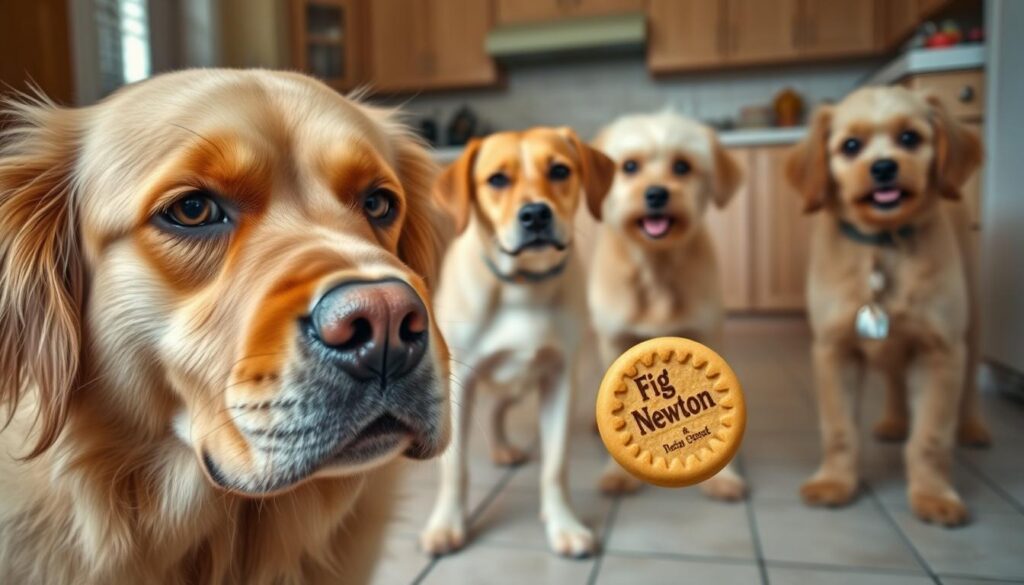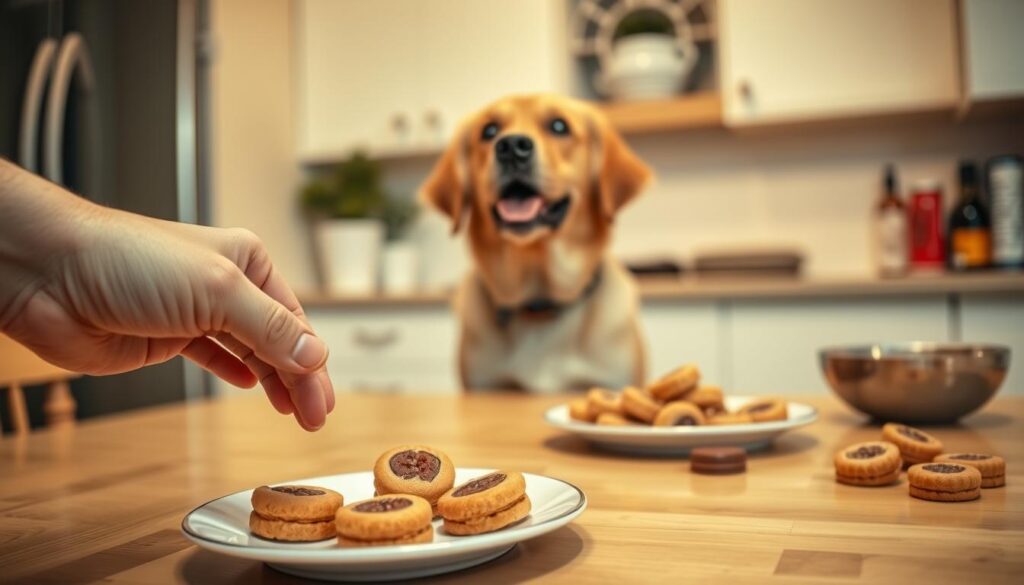Did you know that over 80% of pet owners admit to sharing human snacks with their furry companions? While those pleading eyes are hard to resist, some treats, like Fig Newtons, carry hidden risks your pup’s body isn’t built to handle.
These chewy cookies might seem harmless, but they’re packed with sugars, preservatives, and wheat flour. Veterinarians warn that even small amounts can upset sensitive stomachs, especially in breeds like German Shepherds. “Dogs process food differently,” explains one vet. “What’s sweet for us can be stressful for their systems.”
That doesn’t mean all figs are off-limits. Fresh fruit offers fiber and vitamins in moderation. The problem lies in the added ingredients baked into store-bought snacks. We’ll break down what makes Fig Newtons risky, how to spot early signs of discomfort, and vet-approved alternatives your dog will love.
Key Takeaways
- Human snacks like Fig Newtons contain ingredients that may harm dogs.
- Sugar and preservatives can trigger digestive issues or allergies.
- German Shepherds often have sensitive stomachs requiring special care.
- Fresh figs (in small amounts) are safer than processed versions.
- Always consult your vet before introducing new foods.
Understanding Fig Newtons: Ingredients and Their Effects on Dogs
What’s actually inside those soft-baked squares? Let’s unpack the components of this popular snack and how they interact with canine biology.
Breaking Down the Recipe
Fig paste sits at the core of these treats, offering natural fiber and vitamins like potassium. While fresh figs can support digestion in tiny amounts, processed versions add layers of risk. Wheat flour—a common base—often triggers allergies in sensitive breeds. Added sugars spike insulin levels, and preservatives like citric acid may cause stomach irritation.
Breed-Specific Sensitivities
German Shepherds face higher risks due to their delicate digestive systems. Their bodies struggle with sudden sugar intake, which can lead to diarrhea or vomiting. Even small portions might overload their diet with empty calories, displacing nutrient-rich meals. “Every treat should serve a purpose,” notes Dr. Emily Carter, a veterinary nutritionist. “Human snacks rarely meet that standard.”
While fiber from figs benefits health, store-bought versions pack up to 12 grams of sugar per serving, equivalent to three sugar cubes. Combine this with artificial additives, and you’ve got a recipe for discomfort. Always prioritize vet-approved treats tailored to your dog’s needs.
Can Dogs Eat Fig Newtons? – What Vets Say
Veterinary experts raise red flags about sharing processed snacks with pets. While fresh figs offer fiber and antioxidants, their baked counterparts often contain ingredients that clash with canine biology.

Veterinary Perspectives on Fig Newton Safety
Most vets strongly discourage feeding these treats. Dr. Sarah Thompson, a board-certified veterinary nutritionist, states: “Even occasional nibbles can strain their system. Sugar spikes and artificial additives create cumulative risks that many owners underestimate.”
Natural figs provide magnesium and vitamin B6, but store-bought versions lose these health benefits during processing. What remains? Concentrated sugars (up to 55% per cookie) and preservatives like potassium sorbate. These elements disrupt gut balance and may trigger reactions in sensitive breeds.
Key Warnings and Signs of Trouble
Watch for these symptoms if your pet snags a cookie:
- Vomiting or diarrhea within 6-12 hours
- Lethargy or refusal to eat
- Excessive scratching (allergy indicator)
Toxic dogs don’t always show immediate distress. Chronic exposure to high-sugar snacks can lead to pancreatitis or weight gain. Always contact your veterinarian if symptoms persist beyond 24 hours.
Remember: A balanced dog diet prioritizes species-specific nutrition. Later sections will explore safer ways to treat your pup without compromising their well-being.
Moderation and Safe Practices When Sharing Treats
Finding the right balance between treats and health keeps tails wagging safely. While occasional snacks can strengthen your bond, they should never replace nutrient-rich meals. Let’s explore how to enjoy these moments without compromising your pet’s well-being.

Portion Control and Appropriate Serving Sizes
Moderation is your best tool. Human snacks should make up less than 10% of daily calories. For a 50-pound dog, that’s roughly 40-50 calories max. Break treats into pea-sized pieces—this stretches rewards while controlling intake.
Always check ingredient lists. Remove fillers like chocolate or xylitol first. “Treats should complement their main food, not compete with it,” advises Dr. Lisa Park, a veterinary dietitian. Stick to vet-approved options designed for canine digestion.
Practical Tips for Minimizing Risk
Use treats strategically during training sessions rather than free-feeding. Store snacks in sealed containers to prevent accidental overeating. Watch for subtle signs like slower movement or reluctance to play—these might indicate weight gain or discomfort.
Overfeeding risks include:
- Digestive upset (vomiting or diarrhea)
- Long-term obesity concerns
- Nutritional imbalances
When in doubt, consult your vet about personalized portion guidelines. They’ll consider age, breed, and activity levels to create a safe plan. Remember: every bite counts toward their overall health.
Potential Risks Associated with Fig Newtons
Behind the sweet taste of these snacks lies a cocktail of risks for pets. Many owners don’t realize how quickly ingredients like wheat flour and artificial sweeteners can disrupt a dog’s system. Immediate stomach upset often masks deeper, long-term health threats.

Digestive Issues and Allergic Reactions
Even small amounts can trigger sudden discomfort. Vomiting and diarrhea are common within hours of consumption, especially in sensitive breeds. These symptoms signal your pet’s struggle to process unfamiliar sugars and preservatives.
High sugar content poses a stealthier danger. Over time, repeated exposure stresses the pancreas, increasing risk of pancreatitis or diabetes. One vet notes: “What starts as occasional treats can spiral into chronic conditions if left unchecked.”
Watch for these red flags after accidental ingestion:
- Persistent stomach gurgling or bloating
- Skin irritation from allergic reactions
- Unusual lethargy lasting more than a day
While fresh foods sometimes earn vet approval, processed versions lack nutritional value. Their empty calories displace balanced meals, creating gaps in essential nutrients. Always monitor your pet closely after any human snack exposure—quick action prevents minor issues from becoming emergencies.
Healthy Alternatives and Safer Treat Options for Your GSD
Rewarding your furry friend doesn’t require compromising their well-being. Plenty of nutritious options satisfy cravings while supporting their health. Let’s explore smarter choices that keep tails wagging safely.

Fresh Figs and Natural Dog Treats
Fresh figs (peeled and seedless) can be a rare snack when served sparingly. They offer fiber and potassium without processed sugars. Always slice them into tiny pieces to prevent choking, and never replace meals with fruit.
Compare this to store-bought cookies: Natural options like freeze-dried liver bites or pumpkin-based chews skip harmful additives. These provide protein and vitamins instead of empty calories. “Whole-food ingredients digest more easily,” says Dr. Rachel Kim, a veterinary specialist. “They align better with canine biology.”
Other Vet-Approved Snack Ideas
Try these treats vets recommend for German Shepherds:
- Carrot sticks (raw or steamed)
- Blueberries or apple slices (no seeds)
- Single-ingredient jerky with no seasoning
Homemade options work too. Blend plain yogurt with mashed banana, freeze into cubes, and serve as a cooling summer snack. Always introduce new foods gradually and watch for reactions.
Before sharing anything, consult your vet. They’ll help balance nutrition and tailor portions to your pet’s needs. With thoughtful choices, you can treat your companion without the risks of processed sweets.
Expert Veterinarian Advice and What to Monitor
Your pet’s well-being depends on quick action and informed decisions. Recognizing when to seek help can prevent minor issues from escalating. Let’s outline critical moments that require professional guidance.
When to Consult a Veterinarian
Contact your vet immediately if your companion shows vomiting, diarrhea, or difficulty breathing after consuming any human snack. These symptoms often appear within 12 hours and signal urgent care needs. “Delaying treatment risks dehydration or organ stress,” warns Dr. Lisa Park, a veterinary emergency specialist.

Routine check-ups also matter. Schedule annual visits to discuss your pet’s diet, especially if they’ve reacted to treats before. Proactive conversations help tailor nutrition plans that align with their unique health profile.
Watchful Signs After Treat Consumption
Monitor closely for these red flags:
- Excessive drooling or pawing at the mouth
- Sudden lethargy lasting over 24 hours
- Swollen face or hives (allergy indicators)
Even one problematic snack can disrupt digestion. Track their behavior for subtle changes like reduced playfulness or altered bathroom habits. Share these observations with your vet during consultations—they reveal patterns that guide better care.
Remember: Partnering with professionals offers lasting benefits. Their expertise helps you navigate treat choices confidently, ensuring every reward supports your pet’s vitality.
Conclusion
When it comes to treats, not all options are created equal for your dog. While an occasional nibble of processed snacks might seem harmless, ingredients like refined sugars and preservatives clash with canine biology. German Shepherds face particular risks due to their sensitive digestive systems—even small amounts can trigger discomfort.
Prioritize vet-approved snacks designed for your pet’s needs. Fresh figs (peeled and seedless) offer natural fiber without added sweeteners, but portion control remains key. Store-bought alternatives often lack nutritional value while packing hidden dangers like high sugar content linked to obesity and diabetes.
Watch for subtle changes in behavior or digestion after sharing human foods. Symptoms like lethargy or stomach upset signal it’s time to consult your veterinarian. Their guidance ensures treats complement, not compromise, your companion’s health.
Explore nutrient-rich options like carrot sticks or single-ingredient jerky for safer rewards. Remember: every treat shapes your dog’s long-term well-being. Book a consultation today to build a snack plan that keeps their tail wagging—safely and happily.
